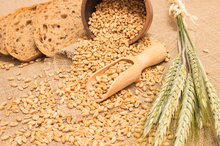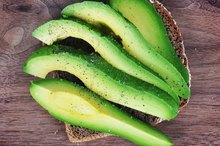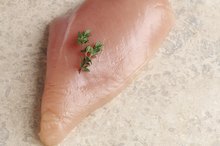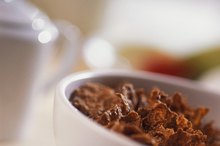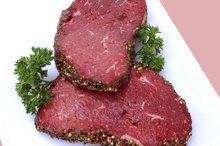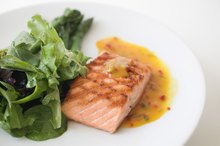What does fact checked mean?
At Healthfully, we strive to deliver objective content that is accurate and up-to-date. Our team periodically reviews articles in order to ensure content quality. The sources cited below consist of evidence from peer-reviewed journals, prominent medical organizations, academic associations, and government data.
The information contained on this site is for informational purposes only, and should not be used as a substitute for the advice of a professional health care provider. Please check with the appropriate physician regarding health questions and concerns. Although we strive to deliver accurate and up-to-date information, no guarantee to that effect is made.
What Food Has More Iron Than Steak?
The proverbial “thick, juicy steak” is a classic recommendation for people who are feeling run down. That’s because beef is rich in iron, a mineral that helps distribute oxygen throughout your body, providing energy and strength. If your doctor confirms you need more iron in your diet, consider foods that are higher in iron than steak and other beef cuts.
Recommended Intake
Teen girls and women in their menstruating years need significantly more iron than their male contemporaries. Girls between 14 and 19 require 15 milligrams each day, while boys of the same age should get 11 milligrams. **Women under the age of 50 need 18 milligrams of iron daily, and men of the same age need 8 milligrams.
** Men and women over the age of 50 require 8 milligrams of iron each day. A 3-ounce steak provides around 2 to 3 milligrams of iron.
- Teen girls and women in their menstruating years need significantly more iron than their male contemporaries.
- Women under the age of 50 need 18 milligrams of iron daily, and men of the same age need 8 milligrams.
Fortified Cereals
Iron Levels in Whole Grains
Learn More
Depending on the brand, fortified cold cereals provide up to 21 milligrams of iron in a serving, and instant cooked cereals provide up to 8 milligrams per serving. Choose whole-grain types for extra fiber. Fortified cereals generally have high amounts of calcium and B-complex vitamins, including folate.
Shellfish
A 3-ounce serving of canned clams delivers 24 milligrams of iron.
Cooked wild oysters provide about 10 milligrams of iron per serving. Shellfish is high in healthy fats, protein, vitamin B-12, copper and zinc. Toss seafood with whole-grain pasta or add it to seafood stews to boost the iron content of your meal.
- A 3-ounce serving of canned clams delivers 24 milligrams of iron.
- Cooked wild oysters provide about 10 milligrams of iron per serving.
Liver and Duck
Foods High in Iron That Will Not Interfere With Coumadin
Learn More
Liver, giblets, kidneys and other organ meats provide up to 10 milligrams of iron with each serving.
The high-iron, protein-rich meats are also high in cholesterol, so reserve meals like liver and onions or collards with giblet gravy for occasions when a “shot” of iron is most needed. At 2.3 milligrams of iron in 3-ounce serving, duck is higher in iron than some steaks.
Duck is also somewhat high in cholesterol and saturated fat. Remove the skin to keep the meal as heart-healthy as possible.
- Liver, giblets, kidneys and other organ meats provide up to 10 milligrams of iron with each serving.
- The high-iron, protein-rich meats are also high in cholesterol, so reserve meals like liver and onions or collards with giblet gravy for occasions when a “shot” of iron is most needed.
Molasses
Each 1 tablespoon of molasses provides 3.5 milligrams of iron. The natural sweetener is also a good source of calcium and potassium. Add molasses to hot cereal or pancakes instead of syrup, or include it in baked goods. Though molasses may have more iron than steak, it is important to know that each offer a different type of iron. Iron from animal sources is called heme iron, because it comes directly from hemoglobin from the blood of the source.
Molasses, and all other plant sources of iron, are referred to as non-heme iron sources. Though these sources have more iron, it is not as easily absorbed as heme iron, according to the National Institutes of Health Office of Dietary Supplements 2.
- Each 1 tablespoon of molasses provides 3.5 milligrams of iron.
- Though these sources have more iron, it is not as easily absorbed as heme iron, according to the National Institutes of Health Office of Dietary Supplements 2.
Dried Beans
Some cooked legumes are higher in iron than beef. A 1/2-cup portion of cooked lentils, soybeans or white beans provides between 3.3 and 4.4 milligrams of iron.
Many other dried beans beat out beef selections such as sirloin steak.
Kidney beans, navy beans, chickpeas, cowpeas, green soybeans, canned refried beans and lima beans all provide at least 2.1 milligrams of iron per serving. Legumes are rich in protein and dietary fiber.
- Some cooked legumes are higher in iron than beef.
Pumpkin Seeds
Pumpkin seeds and winter squash seeds provide about 4.2 milligrams of iron in a 1-ounce serving.
The seeds are a good source of protein, fiber, healthy fats, magnesium, zinc and calcium. Serve roasted winter squash or pumpkin seeds in place of croutons and breadcrumbs in salads and casseroles, or add them to snacks and baked goods.
Spinach
A 1/2-cup serving of cooked spinach provides 3.2 milligrams of iron. Spinach provides almost two days’ worth of vitamin A, and is a rich source fiber, vitamin C and calcium.
Because the oxalic acid in spinach prevents some iron absorption, add foods rich in vitamin C to your meal. Dietary sources like tomatoes and citrus increase the amount of iron your body absorbs from foods.
- A 1/2-cup serving of cooked spinach provides 3.2 milligrams of iron.
- Because the oxalic acid in spinach prevents some iron absorption, add foods rich in vitamin C to your meal.
Related Articles
References
- USDA: Food Sources of Selected Nutrients
- National Institutes of Health Office of Dietary Supplements: Iron
- USDA National Nutrient Database: Spinach, Raw
- Beard, J. L., Dawson, H., & Piñero, D. J. (1996). Iron metabolism: a comprehensive review. Nutrition Reviews, 54(10), 295-317.
- Trumbo, P., Yates, A. A., Schlicker, S., & Poos, M. (2001). Dietary reference intakes: Vitamin A, vitamin K, arsenic, boron, chromium, copper, iodine, iron, manganese, molybdenum, nickel, silicon, vanadium, and zinc. Journal of the Academy of Nutrition and Dietetics, 101(3), 294.
- Allen, L. H. (2000). Anemia and iron deficiency: effects on pregnancy outcome. The American Journal of Clinical Nutrition, 71(5), 1280s-1284s.
- Drukker, L., Hants, Y., Farkash, R., Ruchlemer, R., Samueloff, A., & GrisaruâGranovsky, S. (2015). Iron deficiency anemia at admission for labor and delivery is associated with an increased risk for Cesarean section and adverse maternal and neonatal outcomes. Transfusion, 55(12), 2799-2806.
- Miller, J. L. (2013). Iron deficiency anemia: a common and curable disease. Cold Spring Harbor Perspectives in Medicine, 3(7), a011866.
- Percy, L., Mansour, D., & Fraser, I. (2017). Iron deficiency and iron deficiency anaemia in women. Best Practice & Research Clinical Obstetrics & Gynaecology, 40, 55-67.
- Telford, R. D., Sly, G. J., Hahn, A. G., Cunningham, R. B., Bryant, C., & Smith, J. A. (2003). Footstrike is the major cause of hemolysis during running. Journal of Applied Physiology, 94(1), 38-42.
- Zoller, H., & Vogel, W. (2004). Iron supplementation in athletesâfirst do no harm. Nutrition, 20(7), 615-619.
- Collings, R., Harvey, L. J., Hooper, L., Hurst, R., Brown, T. J., Ansett, J., ... & Fairweather-Tait, S. J. (2013). The absorption of iron from whole diets: a systematic review. The American Journal of Clinical Nutrition, ajcn-050609.
Writer Bio
Ellen Douglas has written on food, gardening, education and the arts since 1992. Douglas has worked as a staff reporter for the Lakeville Journal newspaper group. Previously, she served as a communication specialist in the nonprofit field. She received her Bachelor of Arts from the University of Connecticut.
